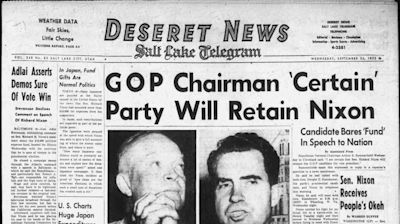Search results
After leaving Washington, Nixon and his wife Pat returned to California and "La Casa Pacifica," their home in San Clemente, California. The former President was a broken man with little idea of what to do next and how to pick up his life. He soon suffered a physical setback as well.
- Life in Brief
Schoolchildren absorb at least one fact about Richard...
- Campaigns and Elections
Richard Nixon's presidential defeat in 1960 and...
- Foreign Affairs
Nixon did not know how to bring the conflict to a successful...
- Impact and Legacy
Richard Nixon's six years in the White House remain widely...
- Family Life
Richard and Pat Nixon were married in 1940, and she...
- Life Before The Presidency
Richard Nixon suffered two great personal losses as a young...
- Domestic Affairs
The study was commissioned by Robert S. McNamara, the...
- Life in Brief
People also ask
What did Richard Nixon do for a living?
What did President Nixon do?
How effective was Nixon as a president?
What losses did Richard Nixon have as a young man?
Richard Milhous Nixon (January 9, 1913 – April 22, 1994) was the 37th president of the United States, serving from 1969 to 1974. A member of the Republican Party, he previously served as a representative and senator from California and as the 36th vice president from 1953 to 1961 under President Dwight D. Eisenhower.
- Early life
- Achievements
- Controversy
- Aftermath
- Political career
- Results
- International relations
- Quotes
- Analysis
- Retirement
While courting common voters, Nixon made the most of his common origins; biographers, both sympathetic and critical, have tended to follow suit. He was born in one small California town (Yorba Linda) and grew up in another (East Whittier). His parents were in some ways oppositesFrank Nixon was as argumentative as Hannah Nixon was sweet-tempered. Ri...
His school life brought a string of successes in endeavors common to politicians in training. He won debates and elections and leading roles in school dramatic productions. His grades were excellent, at both Whittier College and Duke University's law school. His scholastic achievements were not enough, however, to get him the jobs he applied for wi...
His opponent was Jerry Voorhis, a New Dealer elected five times by voters of California's 12th congressional district. Voorhis was an anticommunist and refused to accept the endorsement of any political action committee unless the PAC renounced any and all communist influence. That stance deprived him of backing from the Congress of Industrial Orga...
The House GOP rewarded Nixon with a seat on the House Un-American Activities Committee, where he rose to national stardom during the investigation of Alger Hiss. Through the presentation of evidence before HUAC and at two trials, Hiss, a prominent employee in the U.S. State Department, was revealed to have passed information to the Soviets. Proof o...
In 1950, his reputation buoyed by the Hiss case, Nixon ran for the Senate against Helen Gahagan Douglas in a campaign that echoed his race with Voorhis. This time, the Nixon campaign manual included a \"pink sheet\" comparing his opponent's voting record to that of Communist Party-liner Vito Marcantoniowhat Nixon referred to as the \"Douglas-Marcan...
Nixon's fund may have been unseemlyit was actually used to keep him on the campaign trail, not living \"in style\"but it was not illegal. The candidate defended it in a nationally televised address whose emotional high pointa promise made to his little daughter Tricia never to return one campaign gift, a cocker spaniel puppy named Checkersmade it f...
As vice president, Nixon burnished his reputation for foreign policy expertise with international travel to dozens of countries. His South American tour garnered international headlines when a mob in Caracas, Venezuela, stoned his motorcade. The confrontations with the demonstrators abroad only made him more popular at home. His 1959 trip to the So...
Khrushchev: No, we are up with you on this, too. We have bested you in one technique and also in the other. Nixon: You see, you never concede anything. Khrushchev: I do not give up. Nixon: Wait till you see the picture. Let's have far more communication and exchange in this very area that we speak of. We should hear you more on our televisions. You...
Earlier, when President Eisenhower suffered a heart attack, Nixon's calm, understated performance as temporary steward of the nation's business won him glowing reviews in the news media. But the President's medical problem gave Democrats the opening to claim that a vote to re-elect Eisenhower in 1956 might be, in effect, a vote for Nixon to become ...
Nixon spent much of 1961 writing a book, Six Crises, and contemplating his return to politics. In 1962, he ran for governor of California and lost big. After his last defeat, he held what he claimed was his \"last press conference,\" angrily telling reporters, \"You won't have Dick Nixon to kick around any more.\"
Jun 13, 2012 · During his first term in office, Nixon pursued reforms in welfare, heath care, civil rights, energy and environmental policy, on the belief that such policies had to be based...
Richard Nixon enrolled at Whittier College in September 1930. He was an active student, pursuing his interests in student government, drama, and football while living at home and helping to run the family's store.
Jul 9, 2021 · August 15, 1971, was a fateful day in the history of American economic policy: President Richard Nixon imposed far-ranging wage and price controls on the U.S. economy, abolished the fixed...
In 1972 Richard Nixon became the first sitting U.S. president to visit China. Nixon helped dissolve hostilities between the two nations by meeting with China's leaders...





